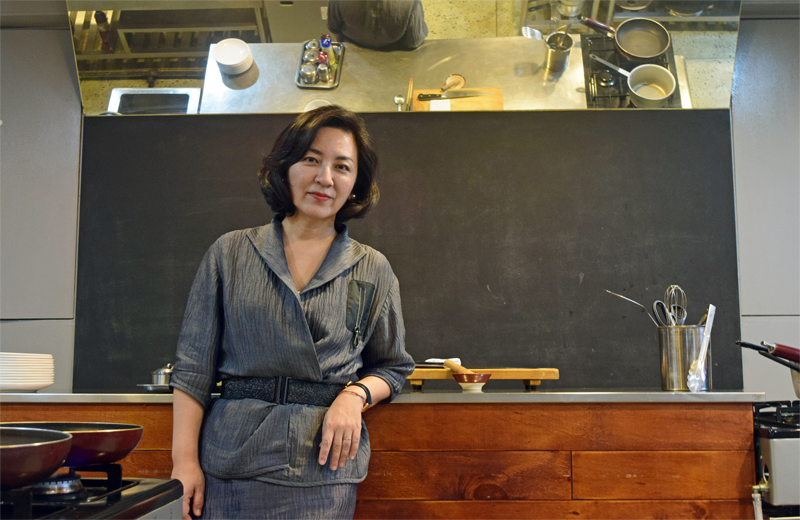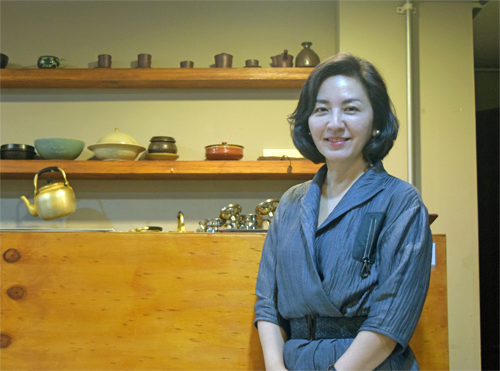 Choi Jia, Food Curator, O’ngo Food Communications
Choi Jia, Food Curator, O’ngo Food Communications
“When we recommend hansik to foreigners, we’d do better not to insist on imparting our own taste but to focus instead on understanding.” 
In the past, the word “hansik” meant food made and eaten by Koreans in their native land. Today, however, few define it as such; while hansik still refers to Korean food, it is no longer enjoyed by Koreans only. What has brought about this change? Has hansik itself transformed, or has there been a shift in foreign perception? Whatever the case, much is owed to the efforts of those who have given their special affection and interest to Korean cuisine. Among them is food curator Choi Ji-a, who has been conducting Korean food tours and cooking classes for foreigners for nearly a decade. Recently, the KF sat down with her to discuss her views on the globalization of hansik.
Hansik has become quite popular internationally in recent years. In addition to a shift in attitudes from the outside world, certain aspects of Korean cuisine itself may have encouraged such a trend. Are there any such elements in particular that stand out to you?
It’s impossible to find just one or two reasons why a specific food culture spreads. Clearly, as exchange with the outside has expanded, Korea and the city of Seoul have become better-known globally and people around the world have been increasingly exposed to Korean food. The constant flow of activities and business by government organizations, enterprises, and private institutions likely contributed to the promotion of hansik overseas, as well. And of course, we can’t neglect the influence of hallyu, or the Korean Wave. As we look back upon the past now, it seems almost strange that Korean food didn’t attract foreigners then.
There may have been changes both big and small in Korean dishes and cookery. But it seems that as the methods of preparing and serving Korean food have moved closer to the global standard, foreigners have been better able to partake. Hygiene has been emphasized in cooking and eating, and the manner of styling and serving has become more sophisticated. Foreign food experts rate good cooking as incorporating “a wide range of flavors” and hansik falls into that category with its variety of tastes. It’s well-balanced nutritiously and, being rich in vegetables, carries an image of being healthy. It has many elements that appeal to the contemporary dietary life that emphasizes well-being.
Back in 2010, you started the culinary tour that some now call the “K-food Tour.” The program must have been rather unfamiliar to the public then.
There are many areas into which food majors can advance after graduating from school. The majority of people run restaurants or directly engage in cooking. Some take up teaching and public lectures, and some go into broadcasting. I wanted to do business using food as the medium, contributing to the globalization and popularization of hansik while offering up an entertaining experience. When I was young I lived in several countries and didn’t like when hansik was underestimated by foreigners. So I wanted to teach foreigners visiting or living in Korea the merits of hansik.
Rather than conducting a study or research project. I came up with a program that enables foreigners to enjoy eating out at local restaurants that are popular among Koreans. They learn the dietary culture and etiquette of Korea while communicating in an informal, friendly atmosphere, just as ordinary Koreans do. Instead of restaurants frequented by foreign tourists, I wanted to help foreigners discover hidden gems of time-honored tradition, and to encourage restaurant owners to talk with program participants so that they could make new friends and memories. A little over 50,000 foreigners have participated in our program so far, and most of them seem to have understood my intentions and have been satisfied.
In addition to the tour program, you communicate with lots of foreigners through cooking classes. Where do they come from? Do their favorite Korean dishes differ by country or region?
The participants in the cooking classes and those in the tour groups have different inclinations. The class participants are serious students of food and cookery, and they’re so focused on their studies that they’re often worried and stressed out. In the beginning, most of the class came from the United States and Canada, but this gradually changed as people from Australia and Europe began to join. These days, participants also come from countries in Asia, South America, and Africa. The classes now see the highest proportion of tourists from Greater China and Southeast Asian countries whose food cultures are relatively similar to Korea’s.
People from countries famous for their cuisine seem more likely to join in food tours and cooking classes when they visit other countries. Tourists from Hong Kong, Taiwan, Singapore, and Thailand tend to appreciate the importance of food more deeply than others. People’s favorite dishes differ vastly by the country or region of their origins. For instance, Singaporeans like haemul pajeon, green onion pancakes with seafood, whereas Russians tend to prefer yukgaejang, a spicy beef soup, and Argentines like sogalbigui, grilled beef ribs. When Pope Francis, who is a native of Argentina, paid a visit to Korea, I was asked to give advice on what to serve him and I recommended the grilled ribs. Despite popular opinion, though, not all foreigners like galbijjim, braised short ribs, or bibimbap, rice mixed with meat and vegetables. When we recommend hansik to foreigners, we’d do better not to insist on imparting our own taste but to focus instead on understanding where these people are from.
You previously published a book introducing hansik and its recipes in English and other languages. What is the appeal of hansik that you want to share with foreigners?
Above all, I want to tell them that hansik isn’t difficult to make. Ingredients may vary by country and region, but a great number of hansik meals can be cooked rather easily and simply by using meat or vegetables that are available anywhere. Other books on hansik have been written in foreign languages, but they often deal with dishes that require a lot of laborious preparation and produce enough food to feed large groups of diners. Now is a time of single living, so I chose to publish a book of one-portion recipes for 28 hansik dishes that are perfect to eat alone and can be cooked easily in the blink of an eye. My book is called “A Korean Kitchen Companion.”
Last but not least, is there anything you want to say to the KF?
I’ve done a lot of projects with the Ministry of Foreign Affairs and have taken part in KF-sponsored events several times as a food consultant. Food may not be the theme of most of the public diplomacy activities of the KF, but it’s been served at many such events, and I hope hansik will be served even more frequently in the future. When the Ministry of Foreign Affairs, the Ministry of Culture, Sports and Tourism; and their affiliated organizations conduct programs for mutual exchange and development with other countries in the form of festivals, exhibitions, or forums, I hope the organizers will make an effort to adopt and serve hansik naturally and more actively so that it can reach as many people as possible.
Interviewed by Kim Daniel
